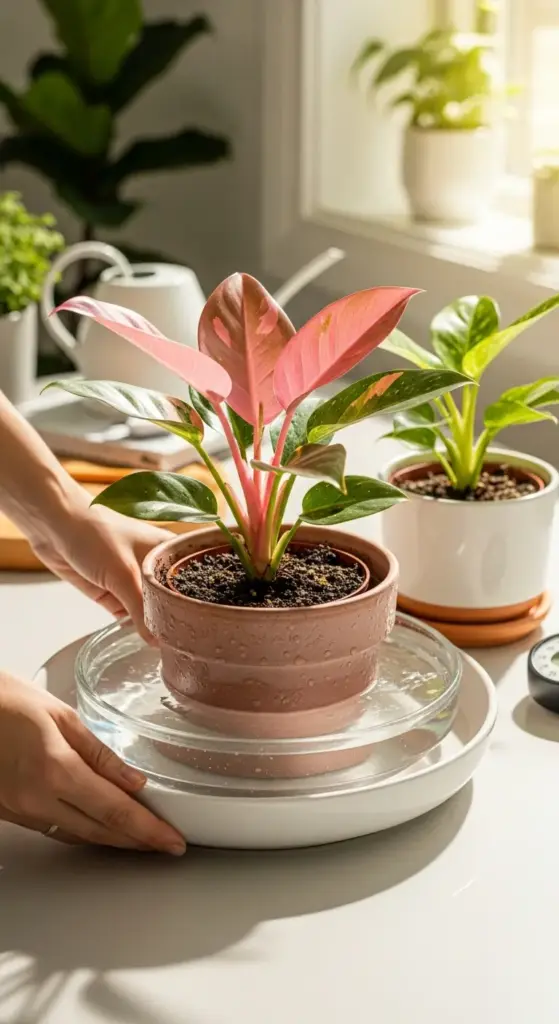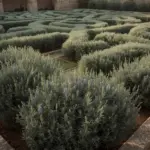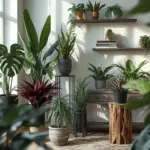6. The Watering Method That Prevents Root Rot Every Time

I used to be a serial plant killer until I discovered this watering technique that completely changed everything. My Pink Princess went from crispy leaf edges to lush perfection using a method that feels totally backwards at first.
This technique saved my $300 Thai Constellation from certain death and now I use it on all my expensive aroids.
The Bottom-Up Watering Revolution
Bottom watering mimics how plants actually drink in nature – through capillary action that draws moisture up from the forest floor. It’s genius when you think about it.
I fill a shallow tray with about 2 inches of water and set my Pink Princess pot directly in it. The plant drinks exactly what it needs through the drainage holes, no more, no less.
This method prevents the soggy top soil that kills so many houseplants. The roots get hydrated without sitting in standing water, which is the perfect recipe for healthy growth.
I was skeptical at first because it goes against everything I’d been taught about watering. But the results speak for themselves – zero root rot in three years of using this technique.
Reading Your Plant’s Thirst Signals
Pink Princess leaves tell you everything you need to know about water needs if you know how to read them. Slightly droopy leaves mean it’s time to water, not bone-dry soil.
The variegated sections actually show water stress first – they’ll look less vibrant and slightly wrinkled before the green parts show any signs.
I check the top inch of soil with my finger, but I also watch for subtle leaf changes. Healthy leaves should feel firm and slightly cool to the touch when the plant is properly hydrated.
Overwatered leaves feel soft and warm, while underwatered leaves feel papery and brittle. It took me months to learn these subtle differences, but now I can tell my plant’s water status just by touching a leaf.
My Exact Bottom-Watering Process
I use a large, shallow plant saucer filled with distilled water about 2 inches deep. The pot sits directly in the water for 30-45 minutes maximum.
Never leave your plant sitting in water longer than an hour – even bottom watering can cause problems if overdone. I set a timer religiously.
After the watering session, I lift the pot and let excess water drain completely. The soil should feel evenly moist but not soggy when you stick your finger down about 2 inches.
I do this process every 7-10 days during growing season, adjusting based on how quickly the soil dries out and what the leaves are telling me.
Seasonal Adjustments That Prevent Problems
Winter watering is where most people mess up – your Pink Princess needs way less water when growth slows down. I cut my watering frequency in half from November through February.
Summer watering increases because of higher temperatures and active growth, but I’m careful not to overcompensate. More frequent, smaller waterings work better than occasional deep soaks.
During spring growth spurts, I watch for increased water uptake. The plant will drain the bottom-watering tray faster when it’s actively producing new leaves.
Fall is tricky because growth slows gradually. I reduce watering frequency slowly rather than making sudden changes that can shock the plant.
Water Quality Secrets Nobody Talks About
Tap water is slowly poisoning your Pink Princess with chlorine, fluoride, and mineral buildup that accumulates in the soil over time. I learned this the hard way.
Distilled water is worth every penny for expensive plants. I buy it in gallon jugs and it costs maybe $20 per year for all my aroids.
Rainwater is even better if you can collect it safely. The natural pH and mineral content is perfect for tropical plants like Pink Princess.
Never use softened water – the salt content will kill your plant slowly. If you have a water softener, use the bypass valve to get unsoftened water for your plants.
Emergency Rescue for Overwatered Plants
If you’ve overwatered, stop watering immediately and remove the plant from its pot to assess root damage. This is scary but necessary.
Healthy roots are white or cream-colored and firm to the touch. Brown, mushy roots need to be cut away with sterile scissors – be ruthless about removing all damaged tissue.
I repot rescued plants in fresh, extra-chunky soil mix with lots of perlite and bark. The goal is maximum drainage while the plant recovers from root damage.
Place the rescued plant in bright, indirect light and don’t water again until you see new growth emerging. This can take 4-6 weeks, but patience saves plants.
The Moisture Meter Myth
Those cheap moisture meters from garden centers are basically useless for chunky aroid mixes. They give false readings and often damage roots when inserted.
Your finger is the best moisture meter – stick it 2 inches down into the soil. If it feels dry at that depth, it’s time for bottom watering.
I also lift my pots regularly to gauge weight. A properly watered pot feels noticeably heavier than a dry one. This technique becomes second nature with practice.
Visual cues from the plant itself are more reliable than any gadget. Learn to read your specific Pink Princess rather than following rigid schedules.
Signs Your Watering Schedule Is Perfect
New growth should emerge consistently without any brown leaf edges or yellowing older leaves. This indicates optimal hydration levels.
The soil should dry out partially between waterings but never become completely bone dry. You want that perfect balance of moisture and aeration.
Healthy Pink Princess roots grow actively and stay white or cream-colored. Root rot shows up as brown, mushy tissue that smells sour or rotten.
Your plant should also maintain good variegation and strong stem structure when properly hydrated. Watering stress often reduces pink coloration in new leaves.
Common Watering Mistakes That Kill Plants
Watering on a rigid schedule instead of reading plant cues is probably the biggest killer of houseplants. Every plant and environment is different.
Using saucers that hold standing water permanently creates perfect conditions for root rot and fungal problems.
Another deadly mistake: watering little and often instead of thorough, less frequent waterings. This creates shallow root systems that can’t support healthy growth.
And please, never water with ice cubes. The temperature shock can damage roots and doesn’t provide proper hydration anyway.
The Results That Made Me a Convert
Since switching to bottom watering, I haven’t lost a single plant to root rot – and I used to kill plants regularly with traditional watering methods.
My Pink Princess produces bigger, more vibrant leaves with consistent variegation. The root system is incredibly healthy and robust.
Water uptake became more predictable, making it easier to maintain proper humidity and feeding schedules. Everything about plant care got easier once I mastered this technique.
Advanced Bottom-Watering Tips
For multiple plants, I use large storage containers as communal watering trays. This saves time and ensures consistent moisture levels across my collection.
Adding a few drops of liquid fertilizer to the bottom-watering tray delivers nutrients directly to the root zone during growing season.
I also use this method for propagating cuttings – the consistent moisture from below encourages faster root development without the risk of stem rot from overhead watering.
Ready for the final secret that ties everything together? Click “next” to discover the temperature manipulation technique that intensifies pink coloration beyond what you thought possible – this simple trick uses your home’s natural temperature zones and costs absolutely nothing to implement!









GIPHY App Key not set. Please check settings